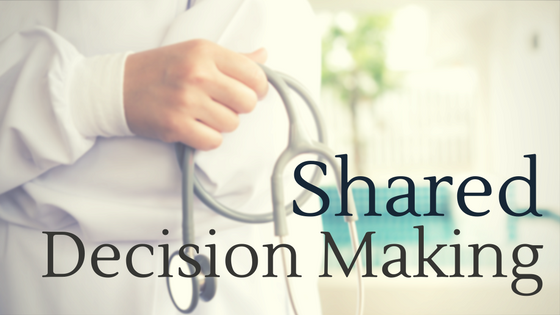Shared decision making is a recent buzzword in medicine, but unlike some other trends that are shallow or flashy, I am very happy that this idea has come into our collective lexicon.
“Shared decision-making puts the ownership in the patient’s hands.”
When my grandmother was sick, I felt such a sense of confusion and loss. The big fancy doctors spoke at my grandmother and father rather than with them, leaving us completely at their mercy.
Cardiac disease was treated like an enigma that couldn’t possibly be understood or self-managed. Understanding the parts of your heart, how they work together, and what happens when they are not functioning properly is essential if you want to maintain a healthy heart. It is possible for you to participate in the health of your heart. When we go to the clothing store, and the sales associate says “What are you looking for today?” we do not shrug our shoulders and say, “Whatever you think is best.” When painters come to paint our house and ask what color we would like, we do not say, “I don’t know.”
Understanding Your Heart Health
We have strong opinions about almost every aspect of our lives. We expect to participate in all the decisions, both big and small, that affect us. So why then, when we sit in the cardiologist’s office, do we sweat bullets and throw up our hands in defeat? “If they know and are better informed, then they can participate and share in the decision-making.” The answer is simply because most people do not understand the processes happening in our hearts.
I have studied the heart for most of my life. During that time, I have watched patients succumb to their own confusion and disengage from their own care. I have also come to realize that the healthiest people, the people who are the most responsible, the people who most diligently follow their health plan, are the ones that have taken the time to learn about their condition. Over the years, I have developed strategies to simplify the complex working of the heart in a way that my patients can understand allowing them to converse comfortably with their doctors. I wrote this book in order to empower my patients and the general public, just like I wanted to be when I watched my grandmother suffer through her illness. While it is completely impractical to expect the average person to go to medical school for every ailment they face, I wanted to create a crash-course in cardiology to make cardiology less intimidating.
Armed with knowledge, patients are better able to advocate for themselves and be a part of their own healthcare.
Participate in your Health
I have found, in my practice, that when patients transfer the responsibility for their health to someone other than themselves, they become apathetic or even hopeless assuming their poor health is out of their power or was inevitable. On the other hand, when patients are able to participate in their healthcare decisions, they feel that it is within their power to change their own circumstances. They are more apt to make healthy decisions and advocate for their needs. Doctors bring their expertise and knowledge of the best medical practices while taking into account the patient’s value and preferences. If a patient is very wary of taking drugs to mediate a medical condition, a doctor who forces them to do so as the first course of action will surely find that the patient is not consistently following the recommendations. Whereas a doctor who takes that into account and uses a multi-pronged approach that puts less emphasis on drugs will certainly see better results with a happier and healthier patient. This is the founding principle of shared decision-making. While this is not a new concept, I hope that the "Your Heart House," makes an impact in helping both doctors and patients reach a more common understanding of cardiology and heart health.
This is a cutting-edge concept with various hospitals and companies working hard to create innovations that will help foster increased participation from patients. The Mayo Clinic created a national resource center to provide both hospitals and patients with tools to help better bridge the knowledge gap. They provide resources that detail side effects, common health issues, and possible avenues of care. Similarly, hospitals across the country are implementing policies to encourage doctors to bring patients into their own care.

